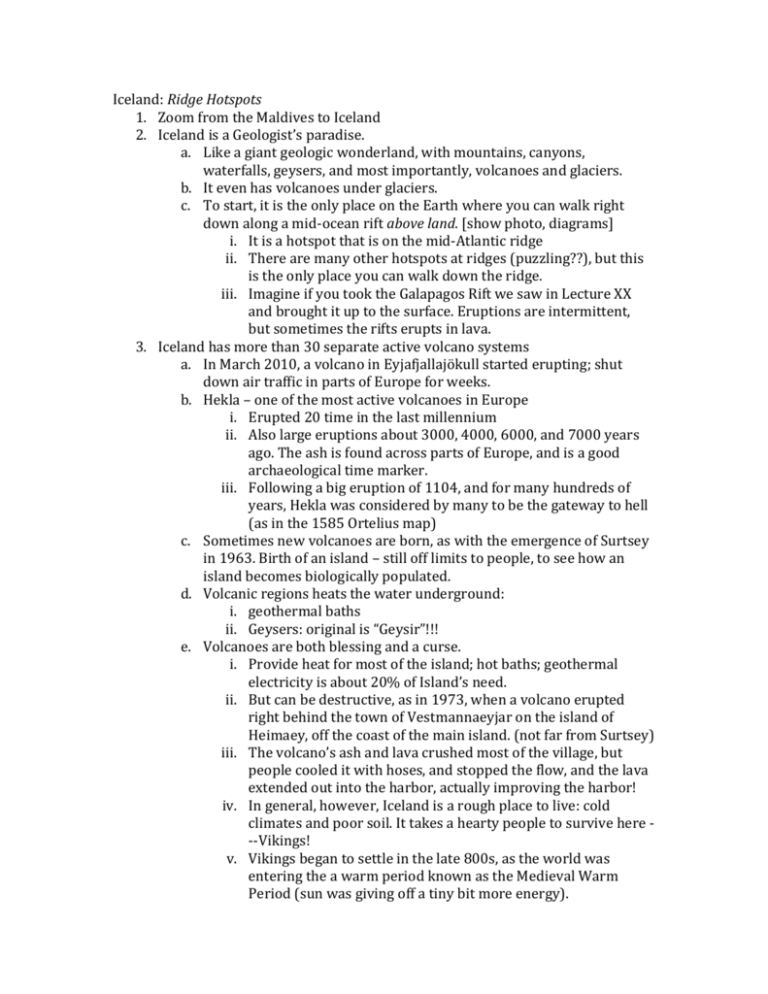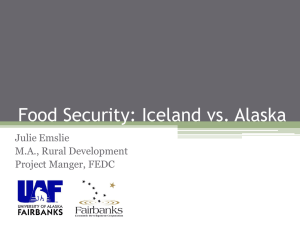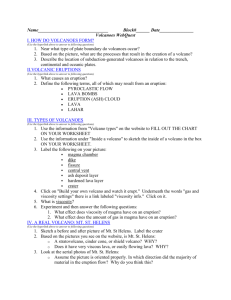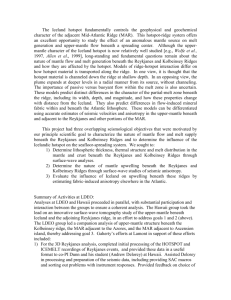Iceland_Out
advertisement

Iceland: Ridge Hotspots 1. Zoom from the Maldives to Iceland 2. Iceland is a Geologist’s paradise. a. Like a giant geologic wonderland, with mountains, canyons, waterfalls, geysers, and most importantly, volcanoes and glaciers. b. It even has volcanoes under glaciers. c. To start, it is the only place on the Earth where you can walk right down along a mid-ocean rift above land. [show photo, diagrams] i. It is a hotspot that is on the mid-Atlantic ridge ii. There are many other hotspots at ridges (puzzling??), but this is the only place you can walk down the ridge. iii. Imagine if you took the Galapagos Rift we saw in Lecture XX and brought it up to the surface. Eruptions are intermittent, but sometimes the rifts erupts in lava. 3. Iceland has more than 30 separate active volcano systems a. In March 2010, a volcano in Eyjafjallajökull started erupting; shut down air traffic in parts of Europe for weeks. b. Hekla – one of the most active volcanoes in Europe i. Erupted 20 time in the last millennium ii. Also large eruptions about 3000, 4000, 6000, and 7000 years ago. The ash is found across parts of Europe, and is a good archaeological time marker. iii. Following a big eruption of 1104, and for many hundreds of years, Hekla was considered by many to be the gateway to hell (as in the 1585 Ortelius map) c. Sometimes new volcanoes are born, as with the emergence of Surtsey in 1963. Birth of an island – still off limits to people, to see how an island becomes biologically populated. d. Volcanic regions heats the water underground: i. geothermal baths ii. Geysers: original is “Geysir”!!! e. Volcanoes are both blessing and a curse. i. Provide heat for most of the island; hot baths; geothermal electricity is about 20% of Island’s need. ii. But can be destructive, as in 1973, when a volcano erupted right behind the town of Vestmannaeyjar on the island of Heimaey, off the coast of the main island. (not far from Surtsey) iii. The volcano’s ash and lava crushed most of the village, but people cooled it with hoses, and stopped the flow, and the lava extended out into the harbor, actually improving the harbor! iv. In general, however, Iceland is a rough place to live: cold climates and poor soil. It takes a hearty people to survive here --Vikings! v. Vikings began to settle in the late 800s, as the world was entering the a warm period known as the Medieval Warm Period (sun was giving off a tiny bit more energy). 1. The sea around Iceland had been frozen for half the year (and would be again during the Little Ice Age). 2. Still carry some of the old Norse traditions, that used to hold throughout scandanavia. People still take the name of their father as their last name. 3. Magnusson is “Son of Magnus;” Ragnarsdottir is “daughter of Ragnar” 4. Very few different names in the phone book! f. Sometimes the volcanoes erupt under the glaciers, melting a lot of ice quickly, as in 2011 with Grímsvötn volcano, located under the thick ice of one of Europes largest glaciers, the Vatnajökull. g. This eruption was in the same region as the famous 1783-4 eruption of Laki fissure and the adjoining Grímsvötn volcano; poured out 14 km3 (3.4 cu mi) of basalt lava and clouds of poisonous hydrofluoric acid/sulfur-dioxide compounds i. killed over 50% of Iceland's livestock population, famine killed approximately 25% of the population. ii. Laki eruption killed over six million people globally, making it the deadliest volcanic eruption in historic times. The drop in temperatures caused crop failures in Europe, droughts in India, and Japan's worst famine. 4. Iceland has glaciers located in many regions about the island, but most of the ice is located in one large ice cap, Vatnajökull, which has over 3000 km3 of ice in it. a. About 10% of Iceland is covered with glaciers. b. When an eruption occurs underneath the glacier, an enormous outrushing of water can occur – a jökulhlaup. c. The melting of glaciers also creates some spectacular waterfalls i. Like the multi-stepped Gullfoss (Golden Falls), or Dettifoss 5. No geologist doubts that Iceland is a hotspot, with an enormous outpouring of lava at this one location. But there is a huge debate as to what is actually causing it. a. Seismic tomography does show a region of warm rock extending down into the mantle, but it is not clear how far down it goes; might not go all the way down to the top of the core, as with Hawaii b. The hotspot also doesn’t seem to be “hot:” the surrounding crust doesn’t have unusually high heat flows, as with Hawaii. There is just a whole lot of lava flowing out! c. However, there IS a large gravity anomaly – the whole crust in that regions seems to be lifted up from below, which is supportive of the idea of a mantle plume there. d. One hypothesis – it is a “wet spot,” a region of slightly higher water content in the mantle rock, which lets it melt more easily. e. Or, it could be former ancient ocean crust that got subducted the last time the Atlantic closed up, and is still floating around down there. It melts more easily, so as it is slowly pulled toward the ridge, it melts more voluminously. f. One thing for certain, when the Iceland hotspot first appeared, it had an effect even greater than changing European climates or shutting down airports; it tore off a piece of Europe! i. When Pangaea started breaking up, Greenland was part of Europe, directly adjacent to Scandinavia. ii. The Mid-Atlantic ridge ran up between Labrador (Canada) and Greenland, through what is now the Labrador Sea. The first outpourings of lava were about 65 million years ago. It came out in several areas, and some people hypothesize the plume was under Greenland and came out in several locations. iii. About 35 million years ago, however, the bulk of the Iceland hotspot lava came out between Greenland and Scandinavia, (remains seen on both sides of the Atlantic there), and the MidAtlantic ridge jumped! iv. Like perforating a piece of paper. v. Labrador sea is now extinct, though still gets a few earthquakes now and then. vi. Iceland’s oldest observed lava is 20 million years old. 1. Q? Is the ridge there because of the hotspot, or is the hotspot there because of the ridge. 2. Lab experiments (corn syrup) and computer simulations show that either could be the case. 3. Won’t know for 10s of millions of years, perhaps. vii. It may be the case that when a supercontinent like Pangaea breaks up, mantle plumes like Iceland are responsible for determining exactly where the plates break. 6. Top 5: a. Tristan de Cunha – first erupted when SAmer and Afr broke up i. May have triggered the separation ii. Seen in Parana (Brazil) and Etandeka (Angola/Namibia) flood basalts that are >135 Ma old. iii. Tristan is now at the ridge, still active b. St. Peter and St. Paul rocks – islands at the equator in the Atlantic Ocean. – Faulting has pulled the crust off of the mantle, exposing mantle rock (peridotite). In fact, only place where the mantle is exposed at the surface. c. Azores – sit at the junction of 3 plates – NAmer, Eurasian, African. d. Afar – sits at the end of the Red Sea, and may be responsible for opening it. More later (in last lecture). Questions: 1) Why do Iceland’s volcanic eruptions affect Europe more than North America? 2) Iceland gets a lot of its electricity from geothermal and hydroelectric resources. Why doesn’t it have any resources of coal or oil? Hawaii should go before Iceland - it is the quintessential hotspot.








